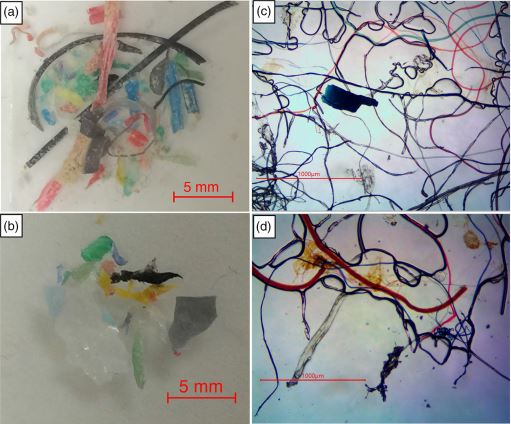A new study led by researchers at Carleton University has found that microplastic pollution is prevalent in the Ottawa River and its tributaries.
Of 62 open water samples and 10 sediment samples, the researchers found that the concentration of microplastic per 100 litres of water was 0.1 fragments per litre. Larger samples taken from the middle of the Ottawa River had a mean concentration of 1.35 fragements per m3. The researchers also found that concentrations of plastic pollution were much higher downstream of the wastewater treatment plant, 1.99 fragments per m3, while upstream concentrations were 0.71 fragments per m3.
Examples of microplastics that were recovered during sampling of the Ottawa River. (a) and (b) are examples of secondary plastic fragments. (c) and (d) are examples of the plastic particles in sediment samples. Plastic microfibers in (c) and (d) were the most common form of plastic particles observed by the researchers. Note the size difference. Courtesy, facetsjournal.com
Commenting to Global News, Jesse Vermaire, assistant professor of environmental science, geography and environmental studies at Carleton University and lead author of the study, said, “What really surprised us is that we found plastic particles in every single water and sediment sample we took, so the plastic was really prevalent in the river system.” The researchers found that between 70 and 100 per cent of all plastic particles collected were microfibres. Plastic microbeads and secondary plastic fragments were also recovered.
The study concluded that, “the effects of microplastic pollution, if any, on freshwater ecosystems and human health remain an important knowledge gap in our management of water quality for the protection of aquatic life.” Furthermore, the researchers assert that reliable and repeatable sampling methods for reporting microplastic pollution be developed. They also noted that a growing body of research indicates that microplastic pollution of freshwater ecosystems may be ubiquitous, and as such, “that we increase our understanding of the spatial and temporal variability of plastic pollution in freshwater systems.”
There has been persistent concern at the level of plastic and microplastic pollution in the Great Lakes for some years. And, recently, microplastic pollution in the Great Lakes has been the target of policy recommendations by the International Joint Commission (IJC). The IJC has made similar sampling and health assessment recommendations to the Canadian and U.S. governments as the research conducted by Vermaire et al. recommends.
In November 2016, the Government of Canada announced that it would ban microplastic beads in toiletries. However, as Vermaire said to Global News, “It’s great that the industry and the government decided to phase out microbeads … it’s really microbeads that got people’s attention on this issue. But the fibres are way harder to control.”
The full report can be found online at the Ottawa Riverkeeper website. Ottawa Riverkeeper’s senior scientist, Meaghan Murphy, co-authored the research.














